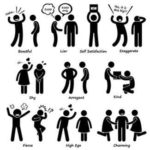Interpersonal Chemistry and Body Language and Sales
 Many pitches are won not because you are brilliant, but because the client simply likes you. I’ve sat on both sides of the advertising agency and client sales table and I can safely say, from my client side, that interpersonal chemistry is a critical factor in agency selection decision making.
Many pitches are won not because you are brilliant, but because the client simply likes you. I’ve sat on both sides of the advertising agency and client sales table and I can safely say, from my client side, that interpersonal chemistry is a critical factor in agency selection decision making.
Given the similarities of agency A to B to C to D (especially by the time an agency has made a client’s short list), interpersonal chemistry — the… “Hey, I like these guys” vibration will be the “all agencies sound the same” deal breaker. Actually, based on many of the interviews in my book on pitching (see above), chemistry is THE decision maker. If we agree that interpersonal chemistry is a critical component in agency selection, then we better get out our test tubes.
I believe that interpersonal chemistry can be managed. Your agency simply (OK, nothing is that simple), should think hard about a few elements of creating love. Here are some:
- Study the client’s brand history and, especially, its and its category’s, marketing pain points. In the best of all possible worlds, you already did this to get into the meeting in the first place.
- Get to learn who the individual clients are. You have a world of tools to ID and learn about each decision making client. This research on work and personal history, education, social media posts, etc. forms the back bone of your account based marketing program. I tell all of my clients that there is no such thing as a blind-date in 2017.
- Ask for a pre pitch chemistry meeting. And, make this critical meeting work for you.
- Back to the dating metaphor: remember the meeting is about them, not you. This may be one of the biggest mistakes an agency makes. The client needs to know how you will address their issues. Not, list ad nauseam the elements of your unrelated really cool Instagram program.
Body Language Is Critical
One experiment that you don’t want to run in the face-to-face meeting is how to manage, use, and read body language. This isn’t new territory for most agency people as we spend a fair amount of time trying to decipher our current client’s body language in strategy and creative meetings. It really is amazing to see the difference between a client that leans in and one that folds their arms, crosses their legs, and leans back.
Albert Mehrabian, the Professor Emeritus of Psychology at UCLA is well known for his study of verbal and non-verbal communication. According to Mehrabian’s 3 V’s of Communication, visual cues rule. Here’s his take on the relative value of three elements in face-to-face communication:
- Verbal – words, content – 7%
- Vocal – tone, pitch, intonation – 38%
- Visual – body language, facial expression, gestures – 55%
- Wow, content only gets 7%!?
I was a bit dumbfounded when I first saw this verbal, vocal, and visual breakdown. Is it possible that non-verbal communication is the essential ingredient of a successful presentation? Well no. And, that isn’t what Mr. Mehrabian is saying. Here is how a sage Wikipedian reports on Mehrabian’s conclusions.
“It is not the case that non-verbal elements in all senses convey the bulk of the message, even though this is how his conclusions are sometimes misinterpreted. For instance, when delivering a lecture or presentation, the textual content of the lecture is delivered entirely verbally, but the non-verbal cues are very important in conveying the speaker’s attitude towards what they are saying, notably their belief or conviction.”
Ah, the demonstration of “belief or conviction”.
This point is very important because we know that there can be an element of distrust in how some clients in the room might view an advertising agency presentation – “Oh, they will say anything to win the account; they are ad guys after all.”
I think that some of this client-think comes from the nature of our presenting the intangible magic of advertising (and, lately, the BS of digital marketing). A sense of disbelief is part of being on the buyer end of any somewhat subjective sales pitch. Therefore, we need to pay close attention to our non-verbal cues.
Playing to the intangibles of body language requires you to play two roles.
- The first is the role of observer. Is the client leaning in? Are they making eye contact or looking around the room or at their papers? How are they holding their arms (hopefully, not folded in front of them)? Are they fidgeting? Better, are they nodding in agreement, and are they taking notes?
Make sure that your team understands how to read the important positive and negative ‘tells’. Everyone should think like a poker player. If you need some extra stimulus on how to read the room, watch David Mamet’s great gambling movie House of Games.
2. Your other role is to be aware of your own body language, and make sure that your team is fully conscious of how they deliver their body language. Personally, I have always focused on my breathing, posture, and the position of my hands, head and eyes. I remind myself to go to an out-of-body view of how I might be perceived during the presentation. Self-awareness during the pitch is all-important.
We should want to look relaxed and stand straight. In this case, you also need to beware of looking too cool, or looking like the shifty poker players you see on TV who often want to demonstrate power by acting aloof. Rather, lean in like President Obama or Sean Hannity (hey, I am an equal opportunity viewer). Look like you believe in what you are saying and that you are confident.
Much of your conscious performance will be driven by your rehearsals which will make you familiar with your ideas, words, tone, pace, and body position. It is ok to critique your teammates during the rehearsal. Better that you point out a colleague’s wandering eye problem than have the client experience it later.
Tip:
Be very uber conscious of your surroundings.
Make sure that you actively read the room. Pay attention to your audience, listen closely to their comments for clues, and note their posture. Be prepared to make subtle adjustments to your presentation based on what you are seeing. I have been in pitches where I know that my colleague is failing by watching the audience’s reaction. In a worse case scenario, the speaker isn’t paying attention to his audience — he is just trying to deliver his lines and get though his section. Bad move for him and for you. All of your presenters must be aware of how they are being received and make adjustments. Have a set of visual codes to alert your colleagues about any body language fails. You might want to have your impartial pitch critic (I discuss this in my pitch book) act disinterested in your rehearsal just for practice.




